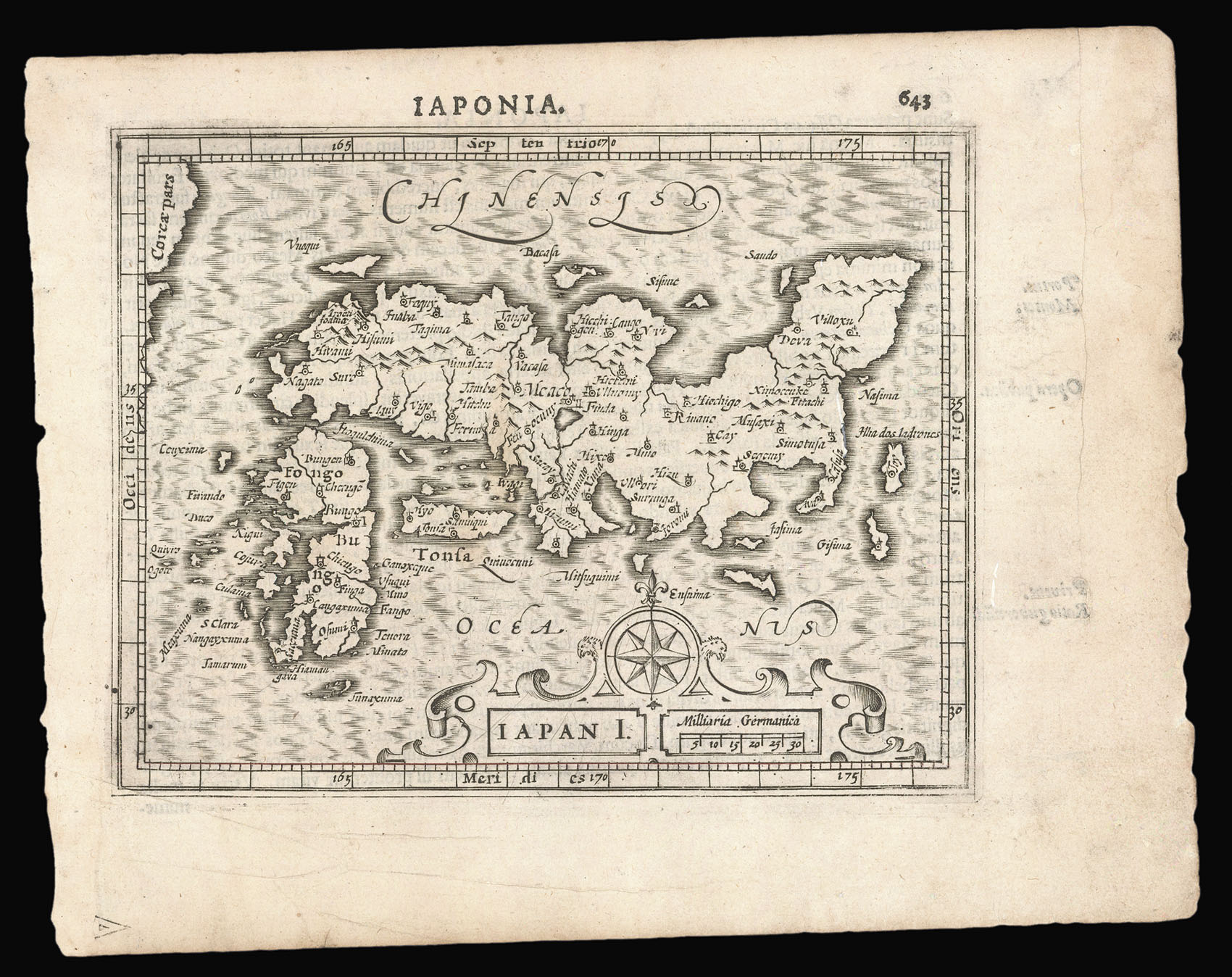

From the first pocket-sized Mercator-Hondius atlas
Iapan I.
- Author: HONDIUS, Jodocus (I); CLAESZ., Corneslis, and JANSSONIUS, Johannes
- Publication place: [Amsterdam,
- Publisher: Jodocus Hondius, Cornelis Claesz., and Johannes Janssonius,
- Publication date: 1610].
- Physical description: Engraved map, Latin text on verso.
- Dimensions: 172 by 222mm. (6.75 by 8.75 inches).
- Inventory reference: 15887
Notes
First state of the plate, published in the second Latin edition of the pocket-sized Mercator-Hondius atlas, 'Atlas Minor de Gerardi Mercatoris…', 1610. 'Essentially copied from the map that appeared in the folio edition of the Mercator-Hondius atlas., although most of Korea is omitted and the bay of Suruga is significantly slimmer. This plate was used in further French, German and Latin editions until 1621. "Sometime after the edition of 1621 the plates were sold and taken to England where they were first used in the 1624 edition of 'Hakluytus Posthumus or Purchas His Pilgrimes'. As the plates were somewhat worn [by then], they were 'refreshed' by re-engraving the lettering and hachuring of the seas" (Hubbard).
In 1570 Abraham Ortelius published the 'Theatrum Orbis Terrarum', the first collection of maps with a uniform size and style. It was an immediate success. Gerard Mercator (1512-94), the inventor of the projection named after him, began in 1585 to produce a series of 'Tabulae Geographicae' of differing European countries. This culminated in 1595 in the 'Atlas Sive Cosmographicae', the first use of the term 'Atlas'. It contained 107 maps of the world. Mercator is one of the giants in the history of cartography; it is he who began the scientific study of the subject. This atlas was completed by his son Rumold, Gerard having died the year before. There was one further edition in 1602 before the plates were acquired by Jodocus Hondius I (1563-1612). He published it as 'Gerardi Mercatoris Atlas Sive Cosmographicae' in 1606 with 37 newly engraved maps, taking the total to 144. Publication had moved from Duisburg to Amsterdam and the first few editions were in Latin. With this atlas Jodocus established the Hondius publishing house in Amsterdam, the center of cartographic production in the late sixteenth century, and built a successful publishing career from his Mercator-Hondius atlas. "After his father's death in 1612, Jodocus Hondius II and his brother, Henricus, took over the family business and began to publish their own atlases, including maps that had previously belonged to their father. Unfortunately, in 1621 Jodocus Hondius II split with his brother, creating a rival publishing house. Henricus Hondius continued his father's business with his brother-in-law, Joannes Jansson" (Krogt). By 1629 the Blaeu family were becoming serious rivals to the publishing partnership of Jan Jansson and Hendricus Hondius, so they "set about revising the Mercator-Hondius atlas which (in respect of the world map) had continued unchanged for nearly thirty-five years" (Shirley 336).
In 1570 Abraham Ortelius published the 'Theatrum Orbis Terrarum', the first collection of maps with a uniform size and style. It was an immediate success. Gerard Mercator (1512-94), the inventor of the projection named after him, began in 1585 to produce a series of 'Tabulae Geographicae' of differing European countries. This culminated in 1595 in the 'Atlas Sive Cosmographicae', the first use of the term 'Atlas'. It contained 107 maps of the world. Mercator is one of the giants in the history of cartography; it is he who began the scientific study of the subject. This atlas was completed by his son Rumold, Gerard having died the year before. There was one further edition in 1602 before the plates were acquired by Jodocus Hondius I (1563-1612). He published it as 'Gerardi Mercatoris Atlas Sive Cosmographicae' in 1606 with 37 newly engraved maps, taking the total to 144. Publication had moved from Duisburg to Amsterdam and the first few editions were in Latin. With this atlas Jodocus established the Hondius publishing house in Amsterdam, the center of cartographic production in the late sixteenth century, and built a successful publishing career from his Mercator-Hondius atlas. "After his father's death in 1612, Jodocus Hondius II and his brother, Henricus, took over the family business and began to publish their own atlases, including maps that had previously belonged to their father. Unfortunately, in 1621 Jodocus Hondius II split with his brother, creating a rival publishing house. Henricus Hondius continued his father's business with his brother-in-law, Joannes Jansson" (Krogt). By 1629 the Blaeu family were becoming serious rivals to the publishing partnership of Jan Jansson and Hendricus Hondius, so they "set about revising the Mercator-Hondius atlas which (in respect of the world map) had continued unchanged for nearly thirty-five years" (Shirley 336).
Bibliography
- Hubbard 14.14
- van der Krogt 351:02.
Image gallery
/
 Rare Maps
Rare Maps  Rare Atlases
Rare Atlases  Rare Books
Rare Books  Rare Prints
Rare Prints  Globes and Planetaria
Globes and Planetaria 










